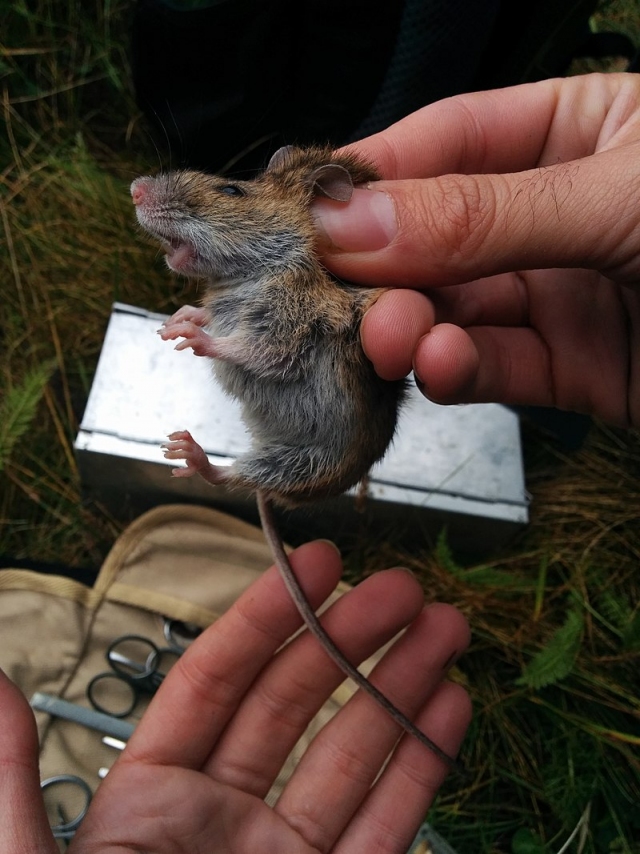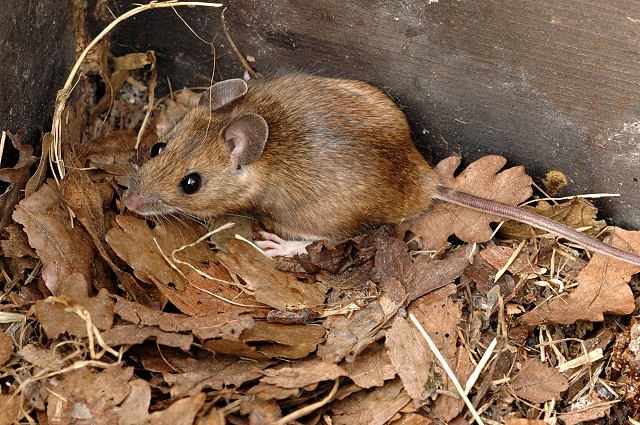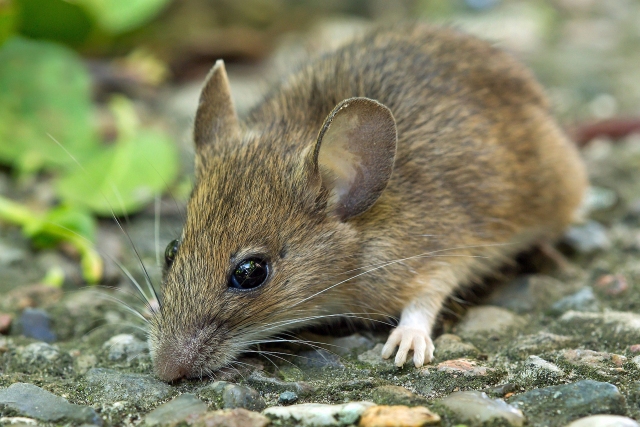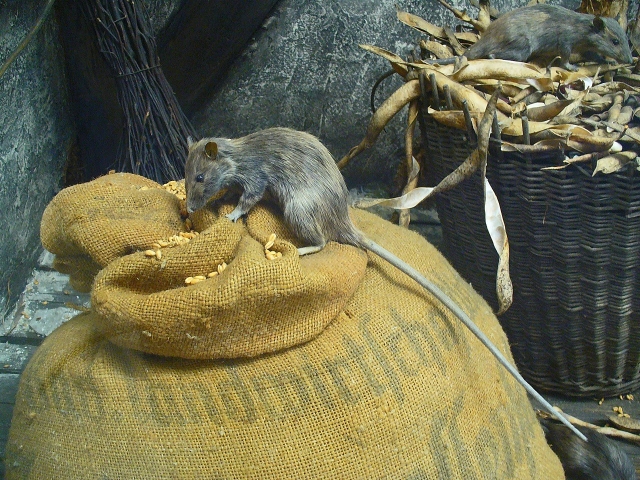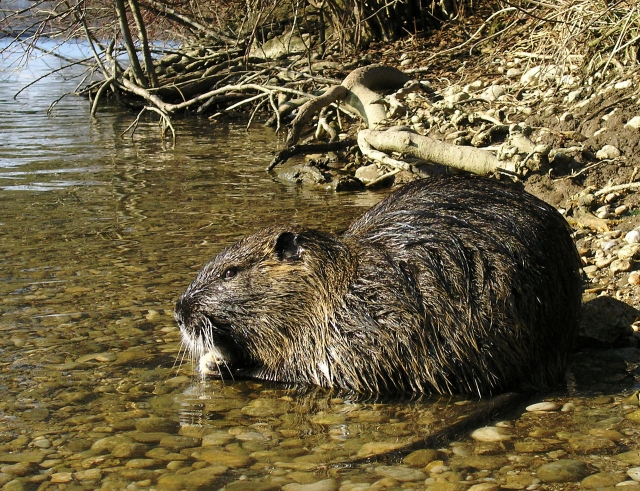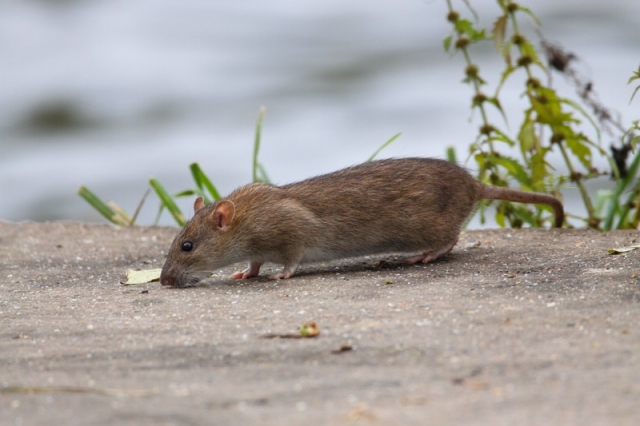Florian Heigl
Alpine field mouse
Description
The snout-vent length is between 9 and 12 cm and the tail length between 10 and 12 cm. The weight varies between 20 and 38 g. The alpine field mouse is brown on the back and on the outside of the limbs, with the upperparts being the darkest. The belly and the inside of the limbs are dark to white-grey. A yellowish spot often occurs on the throat. Morphological differences to the yellow-necked mouse are only found in details of the skull structure. The hind feet are quite large for a wood mouse, about 2.5 cm long. These and the long tail help the animal to climb in rocky terrain.
Habitat
Their habitat is forests or other tree stands interrupted by grassy areas or rocky spots.
The text is a translation of an excerpt from Wikipedia (https://de.wikipedia.org/wiki/Alpenwaldmaus). On wikipedia the text is available under a „Creative Commons Attribution/Share Alike“ licence. Status: 23 August 2021
Yellow-necked mouse
Description
The yellow-necked mouse belongs to the medium-sized species of the genus Apodemus. The ears are relatively large, the eyes large and prominent. The snout-vent length is 88-130 mm, the tail length 90-135 mm, the length of the hind feet 22-27 mm and the ear length 15-20 mm. The animals weight 16-56 g, mostly 26-36 g. The coat is warm reddish or yellowish brown on top. The underpart is almost pure white; the demarcation to the upperpart colouring is very clear. A chest pattern is usually developed in Europe as a continuous yellowish-brown collar. The hind feet have white hairs on top.
Habitat
Yellow-necked mice are largely forest-bound. Older deciduous forests dominated by beech and oak are considered optimal habitats. They also live in hedgerows and gardens with many trees. In autumn, yellow-necked mice often invade buildings. The altitudinal distribution ranges from sea level to about 2100 m in the Alps.
The text is a translation of an excerpt from Wikipedia (https://de.wikipedia.org/wiki/Gelbhalsmaus). On wikipedia the text is available under a „Creative Commons Attribution/Share Alike“ licence. Status: 23 August 2021
Wood mouse
Description
The wood mouse belongs to the smaller species of the genus Apodemus. The ears are relatively large, the eyes very large and clearly protruding. The snout-vent length is 80-110 mm, the tail length 70-115 mm, the length of the hind feet 20.0-23.5 mm and the ear length 15-20 mm. The animals weigh 13-36 g, mostly 18-25 g. The coat is yellowish to brownish grey on top, with a reddish brown overcoat on older animals. The underpart is dirty white, the demarcation to the upperpart colouring is not very clear. The thoracic pattern is absent or only a yellowish brown, longitudinal oval spot. The hind feet have white hairs on top. There is a danger of confusion, especially with the yellow-necked mouse.
Habitat
Contrary to its name, the wood mouse inhabits mainly fringing biotopes of the agricultural landscape in most of its range, especially hedges, fallow land, ditch margins and water banks, but also parks and gardens. In the north-east of the range, the species is largely restricted to these areas and at most inhabits very open, dry coniferous forests here. In the west and south of the range, wood mice also occur in closed upland forests. The main reason for the absence in forests in most of the range is apparently their extensive colonisation by the larger and more competitive yellow-necked mouse.
Wood mice often enter buildings and also use façade vegetation to get under the roof covering.
The text is a translation of an excerpt from Wikipedia (https://de.wikipedia.org/wiki/Waldmaus). On wikipedia the text is available under a „Creative Commons Attribution/Share Alike“ licence. Status: 25 August 2021
Pygmy field mouse
Description
The pygmy field mouse reaches a snout-vent length of 85 to 102 mm, a tail length of 64 to 97 mm as well as a weight of 12 to 26 g. It has hind feet 17 to 22 mm long and ears 14 to 16 mm long. While the coat of the upperparts for western populations is described as grey-brown without yellowish tones, specimens with light sandy or reddish-brown upperparts may occur in Asian populations. In all populations there is a distinct border to the white underpart with a light grey tinge. Furthermore, the tail is divided into a brown upper side and a whitish underpart. The pygmy field mouse has white upperparts on their feets. Occasionally there is a throat patch that differs from the surrounding fur.
Habitat
This rodent prefers to live in lowland or hilly areas up to 400 m altitude. However, it can reach 1400 m in the Carpathians and 3000 m in Asian mountains. The pygmy field mouse prefers to live in semi-open or open landscapes and avoids central areas of forests. It can be found on forest edges, in open forest areas with dense undergrowth, on meadows and fields close to forests or on other cultivated areas. In dry regions, it seeks the vicinity of watercourses.
The text is a translation of an excerpt from Wikipedia (https://de.wikipedia.org/wiki/Zwergwaldmaus). On wikipedia the text is available under a „Creative Commons Attribution/Share Alike“ licence. Status: 25 August 2021
Striped field mouse
Description
The striped field mouse belongs to the smaller species of the genus Apodemus, the tail is relatively short and the ears are smaller than in other representatives of the genus. The snout-vent length is 75-115 mm, the tail length 60-92 mm, the length of the hind foot 16-21 mm and the ear length 10-13 mm. The animals weigh 14-35 g. The coat is warm reddish brown on top, only greyish brown in young animals. A narrow black stripe (dorsal stripe) runs down the middle of the back, extending from the nape of the neck to the rear of the back. The underpart is greyish white.
Habitat
The striped field mouse inhabits richly covered and predominantly moist habitats such as forest edges, bushes, wet meadows and reed banks, but also - and apparently increasingly - gardens and parks. It mainly inhabits lowlands, but occurs in Macedonia up to 1750 m altitude. In summer, the species also inhabits grain fields, in winter it is often found in barns and similar buildings.
The text is a translation of an excerpt from Wikipedia (https://de.wikipedia.org/wiki/Brandmaus). On wikipedia the text is available under a „Creative Commons Attribution/Share Alike“ licence. Status: 25 August 2021
Harvest mouse
Description
The harvest mouse is one of the smallest rodents. It reaches a snout-vent length of 55 to 75 mm, the tail measures about 50 to 75 mm. Its weight is 5 to 7 g. Its upperparts are reddish brown, in some areas also dark brown. The underpart is sharply set off from the back and is white. The unusually long tail is used as a prehensile tail and is bicoloured. The ears barely protrude from the fur. The eyes are very small and dark brown. The skull is also very small; harvest mice can squeeze through holes of one cm in diameter.
Habitat
Their habitat is areas of high vegetation, for example tall grasses, reeds and cane thickets and bamboo thickets, but also grain fields. Occasionally they are also found in hedgerows or rice fields.
The text is a translation of an excerpt from Wikipedia (https://de.wikipedia.org/wiki/Zwergmaus). On wikipedia the text is available under a „Creative Commons Attribution/Share Alike“ licence. Status: 25 August 2021
House mouse
Description
House mice living in the wild reach a snout-vent length of 7 to 11 cm, a tail length of 7 to 10 cm and a weight of about 20 to 25 g. The white mice kept in laboratories and the fancy mice available in the pet shop can become much heavier, 45 to 60 grams are not uncommon. The body is mouse-grey to brown-grey on top, the underpart is somewhat lighter. The tail has clearly visible scale rings and is sparsely hairy.
Adult house mice have longer tails than voles. A vole's tail is shorter than half its torso (from nose to base of tail), a house mouse's tail is longer than half its rump. The incisors of the upper jaw are slightly notched.
There is a similarity to the wood mouse, which also often stays indoors. In wood mice, however, the light underpart is more clearly separated from the darker fur on the upperparts than in house mice. Unlike the house mouse, the wood mouse does not have a notch on the back of the upper incisors.
Habitat
When the house mouse is not living near humans, it mainly inhabits steppes, desert areas and cultivated land. There it digs burrows and builds nests in which it stores its food.
The text is a translation of an excerpt from Wikipedia (https://de.wikipedia.org/wiki/Hausmaus). On wikipedia the text is available under a „Creative Commons Attribution/Share Alike“ licence. Status: 25 August 2021
Black rat
Description
The black rat has a snout-vent length of 17 to 22 cm, a tail length of 18 to 23 cm, the tail has 200 to 260 rings, the weight is about 160 to 210 g.
The snout of the black rat is pointed, eyes and ears are relatively larger than those of the brown rat (Rattus norvegicus). Main colour forms are all grey-black (especially in the subspecies rattus), brown-grey with grey underpart (especially in the roof rat Rattus rattus alexandrinus) and brown-grey with white underpart (especially in the fruit rat Rattus rattus frugivorus). There are transitions and other colour forms in between.
The tail is longer than the body, in contrast to the brown rat, where the tail is shorter than the body.
Habitat
The black rat is only bound to human settlements in colder regions, where it prefers to live in dry residential and storage buildings (especially on upper floors), but also in cellars and stables. In the open, it looks for very different hiding places and builds its nest there.
The text is a translation of an excerpt from Wikipedia (https://de.wikipedia.org/wiki/Hausratte). On wikipedia the text is available under a „Creative Commons Attribution/Share Alike“ licence. Status: 25 August 2021
Nutria
Description
The nutria reaches a body length of up to 65 cm and weighs 8-10 kg as an adult. Its round, scale-covered, barely hairy tail has a length of about 30-45 cm. The animals are thus smaller than adult beavers (maximum snout-vent length about 100 cm, tail length about 35 cm, weight 25-30 kg). On their hind feet they have webbings between the first four toes, the fifth toe is exposed. The orange colouring of the chisel teeth, which is caused by iron deposits, is also conspicuous in adult animals.
The coat colour is reddish brown, slightly greyish on the belly. Animals that have escaped from fur farms also show a number of colour variations. They have light grey, dark grey, black, brown, reddish, yellowish or almost white fur.
Habitat
The original habitat of the nutria, which lives in rivers, lakes, ponds and swamps, is subtropical and temperate South America. In Austria, the population is limited to isolated, usually short-lived populations that regularly do not survive harsh winters. The species is not permanently established there.
The text is a translation of an excerpt from Wikipedia (https://de.wikipedia.org/wiki/Nutria). On wikipedia the text is available under a „Creative Commons Attribution/Share Alike“ licence. Status: 25 August 2021
Brown rat
Description
Brown rats are large, strongly built rats with an angular skull, blunt snout and thick tail, the length of which is normally less than the snout-vent length. The snout-vent length is 18-26 cm, the tail length 14-21 cm and the length of the hind foot 38-45 mm. The tail has 163-205 scale rings. The ears are round and small with a length of 17-23 mm; when folded forward they reach at most the posterior edge of the eye. Sexually mature animals weight about 170-350 g.
Depending on age, the coat is dirty grey-brown on top, reddish brown-grey to dark brown-black, the underpart grey-white. Upperpart and underpart colouration are not sharply separated. Rarely monochrome black animals occur. The tail is bicoloured, greyish brown above and lighter underparts.
Habitat
In their original range in north-east Asia, brown rats inhabit forests and bushy terrain. However, introduced populations are mainly restricted to human settlements, inhabiting drains, rubbish dumps, cellars, warehouses, stables, farms and similar habitats, very often near water. In Europe, the species also inhabits semi-natural habitats, especially water margins with dense vegetation and seashores, especially around river mouths.
The text is a translation of an excerpt from Wikipedia (https://de.wikipedia.org/wiki/Wanderratte). On wikipedia the text is available under a „Creative Commons Attribution/Share Alike“ licence. Status: 25 August 2021

